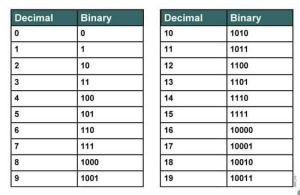Entrance Announcement
MICTE 2080
2080 Magh 07
User:Saroj Neupane Lesson Plan 3: Difference between revisions
Jump to navigation
Jump to search
mNo edit summary |
m (→Assessment) |
||
| (2 intermediate revisions by one other user not shown) | |||
| Line 30: | Line 30: | ||
* Visual aids (binary charts, diagrams) | * Visual aids (binary charts, diagrams) | ||
* Small cards with binary and decimal numbers | * Small cards with binary and decimal numbers | ||
* | * Projector (optional) | ||
==Introduction ( 11 minutes)== | ==Introduction ( 11 minutes)== | ||
| Line 74: | Line 74: | ||
* Evaluate student participation in the activity. | * Evaluate student participation in the activity. | ||
* Ask a few students to explain the process of converting a binary number to decimal (and vice versa) to assess individual understanding. | * Ask a few students to explain the process of converting a binary number to decimal (and vice versa) to assess individual understanding. | ||
[[Category: Lesson Plan]] | |||
__notoc__ | |||
[[Category: BICTE]] | |||
Latest revision as of 03:28, 12 March 2024
| Subject: Computer Science |
| Class:6 |
| Time:15 Minutes |
| Number of Students: 20 |
| Unit:5 |
| Topic: Understanding the Binary Number System |
| Period: 5th |
| School: ABC School |
Specific Objectives
- To introduce students to the binary number system.
- To help students understand the conversion between binary and decimal numbers.
Teaching Materials
- Whiteboard and markers
- Visual aids (binary charts, diagrams)
- Small cards with binary and decimal numbers
- Projector (optional)
Introduction ( 11 minutes)
- Begin with a brief review of the decimal number system, which students are likely familiar with.
- Introduce the idea that computers use a different number system called binary and explain its importance in computer science.
What is Binary? (3 minutes)
- Define binary as a base-2 number system. It describes numeric values by two separate symbols; 1 (one) and 0 (zero). The base-2 system is the positional notation with 2 as a radix.
- Explain the concept of bits (binary digits) being the building blocks of binary numbers, representing 0 or 1.

Counting in Binary (2 minutes)
- Demonstrate how to count in binary from 0 to 15.
- Emphasize the pattern of binary counting (0, 1, 10, 11, 100, 101, and so on). Use visual aids or the whiteboard to show the binary counting sequence.
Binary to Decimal Conversion ( 3 minutes)
- Explain the process of converting binary numbers to decimal.
- Use examples to illustrate the conversion steps.
Decimal to Binary Conversion (3 minutes)
- Discuss the process of converting decimal numbers to binary.
- Provide examples to illustrate the conversion steps.
Student Activity (3 minutes)
- Distribute small cards with binary numbers written on them.
- Ask students to convert the binary numbers on their cards to decimal on the whiteboard.
- Alternatively, i can reverse the process and have students convert decimal numbers to binary.
Conclusion (1 minute)
- Summarize the key points of the lesson: Definition of binary as a base-2 number system.
- Conversion between binary and decimal numbers.
- Encourage students to practice converting numbers on their own to reinforce their understanding.
Assessment
- Evaluate student participation in the activity.
- Ask a few students to explain the process of converting a binary number to decimal (and vice versa) to assess individual understanding.